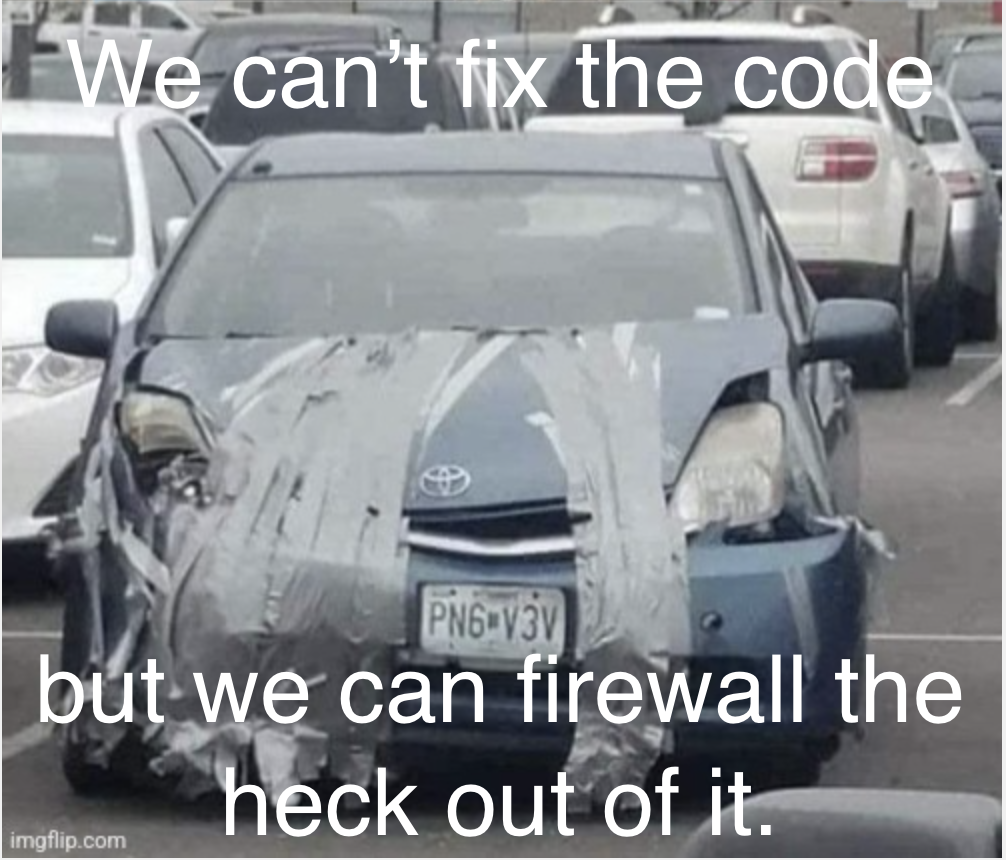Not ready for a demo?
Join us for a live product tour - available every Thursday at 8am PT/11 am ET
Schedule a demo
.svg)
No, I will lose this chance & potential revenue
x
x



Modern security practices like DevSecOps are often discussed in the context of cloud-native, containerized, or microservices-based architectures. However, many organizations continue to rely on legacy systems and large monolithic applications that remain critical to daily operations. These applications (often decades old, tightly coupled, and difficult to modify) are not easily migrated to contemporary software delivery pipelines.
Yet, they present the same security and compliance challenges as modern systems, often with even greater risk due to outdated dependencies, limited automation, and scarce domain expertise. Ignoring them or deferring remediation is not a sustainable option.
This article explores how DevSecOps principles can be tailored to legacy environments. While these applications may not fit neatly into container orchestrators or modern CI/CD pipelines, they can still benefit from the cultural, process, and tooling shifts that DevSecOps promotes. By applying threat modeling, automation where possible, security testing, secrets management, and monitoring, organizations can significantly strengthen the security posture of their legacy infrastructure without requiring a complete re-architecture.
Because even the dinosaurs need defense.
Consider a common reality in many organizations: a large, monolithic application that has been in production for years, perhaps built with older frameworks such as Java 6 or even COBOL components. It may run on dedicated servers that have been carefully maintained but are difficult to modify or scale. Deployment processes are often manual, fragile, and poorly documented, creating significant operational risk.
In this environment, introducing modern DevSecOps practices can feel daunting. Concepts such as shifting security left or continuous delivery seem incompatible with a codebase that resists change and an infrastructure where any modification could disrupt critical business operations.
The challenge, then, is how to apply DevSecOps principles to systems that were never designed for them without rewriting the entire application or destabilizing production.
At its core, DevSecOps is not a collection of tools or platforms. It is a methodology and cultural approach that integrates security practices directly into the software development and delivery lifecycle. Rather than treating security as a final stage or isolated responsibility, DevSecOps emphasizes embedding security early, consistently, and collaboratively across teams.
Fundamental principles include:
While these principles are often associated with modern DevOps pipelines and cloud-native deployments, they are equally relevant to legacy and monolithic applications. The difference lies in how they are applied: introducing automation gradually, wrapping existing systems with safeguards, and ensuring teams are equipped to manage risk in constrained environments.
Legacy and monolithic applications are critical to many organizations, but they are frequently excluded from modern DevOps and DevSecOps initiatives. Several factors contribute to this gap:
Despite these challenges, legacy applications do not have to remain insecure or unmanaged. Mature DevSecOps principles can be adapted to fit within their limitations. The goal is not to force a complete re-architecture but to implement practical measures, such as threat modeling, external security controls, and gradual automation that enhance resilience without destabilizing critical business systems.
Legacy environments are often characterized by undocumented assumptions and ad hoc integrations. Adopting lightweight threat modeling offers a structured approach to identify potential security risks early. This process involves mapping out data flows, authentication boundaries, and parts of the codebase that are more likely to contain vulnerabilities. Modern tools, such as OWASP Threat Dragon and SecurityReview.ai, can expedite this process, but even simple diagrams and checklists can reveal critical exposures.

Even if formal CI/CD pipelines are not in place, it is still possible to enhance deployment safety by introducing automated security checks into existing build, deployment, or maintenance scripts. Recommended measures include static application security testing (SAST), dependency scanning for known vulnerabilities, and verification that no secrets are hardcoded. Tools such as SonarQube, Snyk, Gitleaks, Checkmarx, and GitHub Advanced Security can be adapted to legacy workflows to provide essential coverage.
When rearchitecting legacy applications is not feasible, compensating controls at the infrastructure or network level are important. Reverse proxies with integrated security modules (e.g., NGINX with ModSecurity), API gateways for fine-grained access management, and runtime defenses such as web application firewalls (WAFs) and runtime application self-protection (RASP) solutions can provide critical protection for monolithic applications without requiring substantial code changes.

Effective security monitoring is essential, regardless of application architecture. Centralized logging solutions (such as the ELK stack, Splunk, or Fluentd) should be used to collect and analyze security events. Integration with Security Information and Event Management (SIEM) platforms facilitates correlation and detection of abnormal activity, enabling rapid incident identification and response.
Application security is most effective when all relevant teams (development, operations, and infrastructure) share responsibility and expertise. Regular training should focus on identifying legacy code risks, reviewing secure coding practices, and assessing the security implications of changes. Awareness-building programs can be practical (focused on real-world scenarios relevant to legacy systems) rather than punitive.
Legacy deployments frequently contain hardcoded credentials, API keys, or other sensitive data. Where possible, secrets management solutions (such as HashiCorp Vault, CyberArk, Doppler, or cloud provider secrets managers) should be adopted to securely store and inject secrets into applications or deployment scripts. This reduces the risk of accidental exposure and improves compliance with modern security standards.
.png)
When the monolith finally gets a static code scan after 8 years:

Dev after injecting Vault into a 2009 deployment script:


Securing legacy and monolithic applications is a necessity for organizations that depend on these systems to support critical business processes. While the technical debt and operational constraints of legacy environments pose significant challenges, they are not insurmountable. By applying DevSecOps principles in practical, incremental steps, such as threat modeling, integrating security controls, externalizing defenses, and strengthening monitoring, organizations can meaningfully improve the security posture of even their oldest applications.
Continuous training and cross-team collaboration are essential elements for sustainable progress. Incremental modernization, rather than risky “big bang” rewrites, is both realistic and effective. When security is woven into daily processes, legacy systems can transition from liabilities to resilient, compliant assets, capable of supporting ongoing digital transformation and regulatory requirements.
Ready to take the next step?
AppSecEngineer specializes in hands-on security education tailored for real-world environments, including legacy and hybrid stacks. Explore industry-leading labs, scenario-based training, and expert guidance designed to help your teams implement DevSecOps, modernize old applications, and reduce risk without a complete rewrite. Visit AppSecEngineer to begin your journey toward secure legacy modernization.

A legacy system is typically an older software application or platform that remains critical to business operations but was built before the emergence of cloud-native, DevOps, or DevSecOps practices. These systems often feature monolithic architectures, older programming languages like Java or COBOL, and manual deployment and maintenance processes.
Legacy systems present challenges such as tightly coupled architectures, lack of automated deployment pipelines, minimal documentation, dependencies on outdated technologies, and limited scalability. These factors make it difficult to integrate modern security tools and processes without risking system stability or incurring significant downtime.
Threat modeling helps organizations systematically identify potential security risks in legacy applications by mapping out data flows, authentication boundaries, and areas of vulnerability. This structured analysis enables teams to prioritize security controls and remediation efforts, even for systems with little documentation or complex codebases.
Several security tools can improve the resilience of legacy applications. Static application security testing (SAST) solutions like SonarQube and Checkmarx, dependency scanning tools such as Snyk, and secret scanning utilities like Gitleaks can be used independently or added to existing build or deployment scripts. For runtime protection, web application firewalls, intrusion detection systems, and SIEM platforms provide essential oversight.
Yes. Organizations can enhance security by inserting automated tests, code scanners, and monitoring solutions into existing manual or semi-automated deployment workflows. Gradually introducing these controls, starting with the most critical areas, helps build a security-first mindset over time.
Modern secret management solutions such as HashiCorp Vault, CyberArk, Doppler, and cloud provider secret managers allow teams to securely store and retrieve credentials. Implementing these solutions reduces the risk of credential exposure and brings legacy systems into alignment with best practices.
Centralizing logging using tools like the ELK stack, Splunk, or Fluentd enables visibility into system activity and potential threats. Integrating logs with a SIEM platform or intrusion detection solution enhances threat detection and supports faster, more coordinated incident response.
Ongoing training is crucial for ensuring that development, operations, and security teams understand the risks and requirements of legacy environments. Focused security education helps teams identify vulnerabilities, adopt secure coding practices, and respond effectively to emerging threats.
Integrating DevSecOps principles—such as threat modeling, enforcing access controls, monitoring, and secure coding—supports compliance with standards like PCI DSS, HIPAA, and GDPR, even for legacy applications. Documenting security measures and continuously monitoring for risks is essential for regulatory readiness.
AppSecEngineer provides scenario-based labs and expert-led training focused on securing legacy and hybrid architectures. Visit the AppSecEngineer website for more information on tailored security education and practical modernization resources.


.png)
.png)

Koushik M.
"Exceptional Hands-On Security Learning Platform"

Varunsainadh K.
"Practical Security Training with Real-World Labs"

Gaël Z.
"A new generation platform showing both attacks and remediations"

Nanak S.
"Best resource to learn for appsec and product security"
.svg)




.svg)



.png)
.png)

Koushik M.
"Exceptional Hands-On Security Learning Platform"

Varunsainadh K.
"Practical Security Training with Real-World Labs"

Gaël Z.
"A new generation platform showing both attacks and remediations"

Nanak S.
"Best resource to learn for appsec and product security"


.svg)
.svg)




United States11166 Fairfax Boulevard, 500, Fairfax, VA 22030
APAC
68 Circular Road, #02-01, 049422, Singapore
For Support write to help@appsecengineer.com



.svg)
